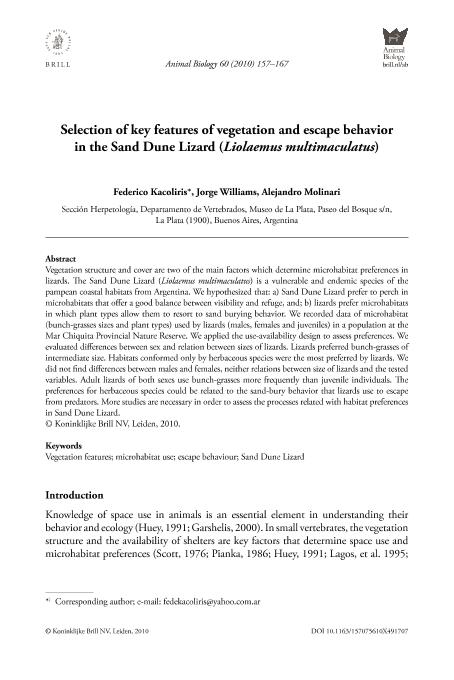Artículo
Selection of key features of vegetation and escape behavior in the sand dune lizard (liolaemus multimaculatus)
Fecha de publicación:
02/2010
Editorial:
Brill Academic Publishers
Revista:
Animal Biology
ISSN:
1570-7555
Idioma:
Inglés
Tipo de recurso:
Artículo publicado
Clasificación temática:
Resumen
Vegetation structure and cover are two of the main factors which determine microhabitat preferences inlizards. Th e Sand Dune Lizard ( Liolaemus multimaculatus ) is a vulnerable and endemic species of thepampean coastal habitats from Argentina. We hypothesized that: a) Sand Dune Lizard prefer to perch inmicrohabitats that off er a good balance between visibility and refuge, and; b) lizards prefer microhabitatsin which plant types allow them to resort to sand burying behavior. We recorded data of microhabitat(bunch-grasses sizes and plant types) used by lizards (males, females and juveniles) in a population at theMar Chiquita Provincial Nature Reserve. We applied the use-availability design to assess preferences. Weevaluated diff erences between sex and relation between sizes of lizards. Lizards preferred bunch-grasses ofintermediate size. Habitats conformed only by herbaceous species were the most preferred by lizards. Wedid not fi nd diff erences between males and females, neither relations between size of lizards and the testedvariables. Adult lizards of both sexes use bunch-grasses more frequently than juvenile individuals. Th epreferences for herbaceous species could be related to the sand-bury behavior that lizards use to escapefrom predators. More studies are necessary in order to assess the processes related with habitat preferencesin Sand Dune Lizard.
Palabras clave:
ESCAPE BEHAVIOUR
,
MICROHABITAT USE
,
SAND DUNE LIZARD
,
VEGETATION FEATURES
Archivos asociados
Licencia
Identificadores
Colecciones
Articulos(CCT - LA PLATA)
Articulos de CTRO.CIENTIFICO TECNOL.CONICET - LA PLATA
Articulos de CTRO.CIENTIFICO TECNOL.CONICET - LA PLATA
Citación
Kacoliris, Federico Pablo; Williams, Jorge Daniel; Molinari, Alejandro; Selection of key features of vegetation and escape behavior in the sand dune lizard (liolaemus multimaculatus); Brill Academic Publishers; Animal Biology; 60; 2; 2-2010; 157-167
Compartir
Altmétricas




